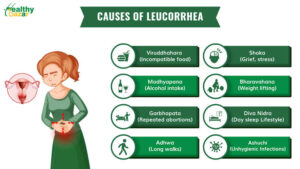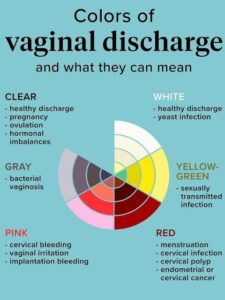LEUCORRHOEA
What is Leucorrhoea?
Leucorrhoea is the normal milky white or clear vaginal discharge. It is usually thin and could have a mild odor. It typically does not come with itching or strong foul odor. Leucorrhoea does not develop all of a sudden. Apart from the normal occurrence during puberty or sexual excitement at times or it is an indication that something is wrong with your body or reproductive system.
As white vaginal discharge can sometimes seem like an infection, it’s important to know when it’s normal to experience leucorrhea and when it’s a problem. Thick, white discharge can occur throughout your menstrual cycle. This discharge is known as leucorrhoea, and it’s completely normal. The discharge may start out thinner in the days leading up to ovulation, or when an egg is released. During ovulation, the discharge or mucus may become very thick and mucus-like. Leucorrhoea will not affect the health if it is caused due to hormonal changes during the menstrual cycle, sexual excitement, early pregnancy, and puberty. If the vaginal discharge is yellowish and has a foul smell, it is commonly due to bacterial or viral infection (sexually transmitted infection). If left untreated, it can lead to severe complications like pelvic inflammatory disease and infertility.
Types of Leucorrhoea
- Physiological Leucorrhoea – Common in almost every woman, and caused by the body’s natural defenses. The mechanism of the vagina is to maintain its chemical balance and preserve the flexibility of the vaginal tissue.
- Inflammatory Leucorrhoea – It happens due to vaginal swelling or congestion inside the vaginal mucosa, the affected area very often gives out yellow-colored discharge with a foul smell. This type of Leucorrhoea also includes vaginal discharge caused by the sexually transmitted disease and due to post-partum discharge after delivery.
- Parasitic Leucorrhoea – It occurs due to trichomonas vaginalis and symptoms are seen like itching, burning sensation with white or yellow, thick, frothy vaginal discharge.
Symptoms
- Thick whitish/ yellowish discharge
- Lower abdominal pain
- Painful intercourse
- Intense itching of the vagina
- Burning sensation while urinating and frequent urge to pass very little urine
- Digestive disturbances like constipation
- Tiredness due to loss of vital fluids as discharges
- Strong smell or frothy discharge
Causes
Whenever our body gets loaded with toxins and the eliminatory organs like skin, bowels, and lungs are unable to expel these toxins, the body will try to flush it out through the mucous membrane of the uterus and vagina in the form of leucorrhoea. Some of the common causes are listed below:
- Improper vaginal hygiene
- Excessive intake of oily, spicy, and unhealthy food
- Hormonal imbalance due to severe mental stress
- Overindulgence in sexual activity
- Following improper diet and lifestyle
- Alcohol & smoking
- Bacterial and fungal infections
Leucorrhoea can also occur due to chills. Chills usually cause the inflammation of the womb and vaginal membranes. Other reasons may be the displacement of the uterus or unhygienic conditions which cause the bacteria to infect genital organs.
Risk factors
The risk of leucorrhoea without any pathology depends on many factors like the age of the woman, educational status, family background, number of pregnancies, use of contraceptives and the method of childbirth. The risk of abnormal vaginal discharges is increased in:
- Sexually active individuals.
- Multiple sexual partners.
- Past untreated infections.
- Unprotected sexual contact.
- Sexually active women under 25 years.
- Previous history of sexually transmitted diseases.
- HIV infection.
- Weak immunity.
- Not using condoms often.
- Use of contraceptive devices.
Steps to prevent leucorrhoea
The following steps can to an extent prevent the occurrence of leucorrhoea.
- Good hygiene and cleanliness during menstrual cycles
- Good dietary habits
- Wash undergarments with an antibiotic solution and let it dry under the sun
- Avoid stress – stress and strain may affect the hormonal levels
- Avoid foods that will aggravate the problem or increase your chances of getting leucorrhoea by avoiding all heavy, oily, fried, sugary, spicy, and sour foods.
Diet management
- Consume – red spinach, green gram, dates, cow’s ghee, amla, ash gourd etc…
- Avoid – alcohol intake, wrong food combinations, night awakening, dry and junk foods, horse riding, exhaustion, excessive sexual indulgence etc…
Yoga and Asanas for Leucorrhoea
Leucorrhoea is a by-product of an unhealthy lifestyle in terms of food, stress, lack of exercises. With the help of yogasanas and pranayama can reduce stress, anxiety and improves body function.
- Parvatasana
- Dhanurasana
- Vajrasana
- Sarvangasana
- Bhadrasana
- Bhujangasana
- Paranayama – Bramari pranayama and meditation.





Can also perform Kegel exercise while sitting down as well. Accordingly, sit on a hard chair and bend forward. As you do so, make sure to contract the pelvic muscles from back to front. Maintain the position for about 15 seconds before returning back to your normal stance.






